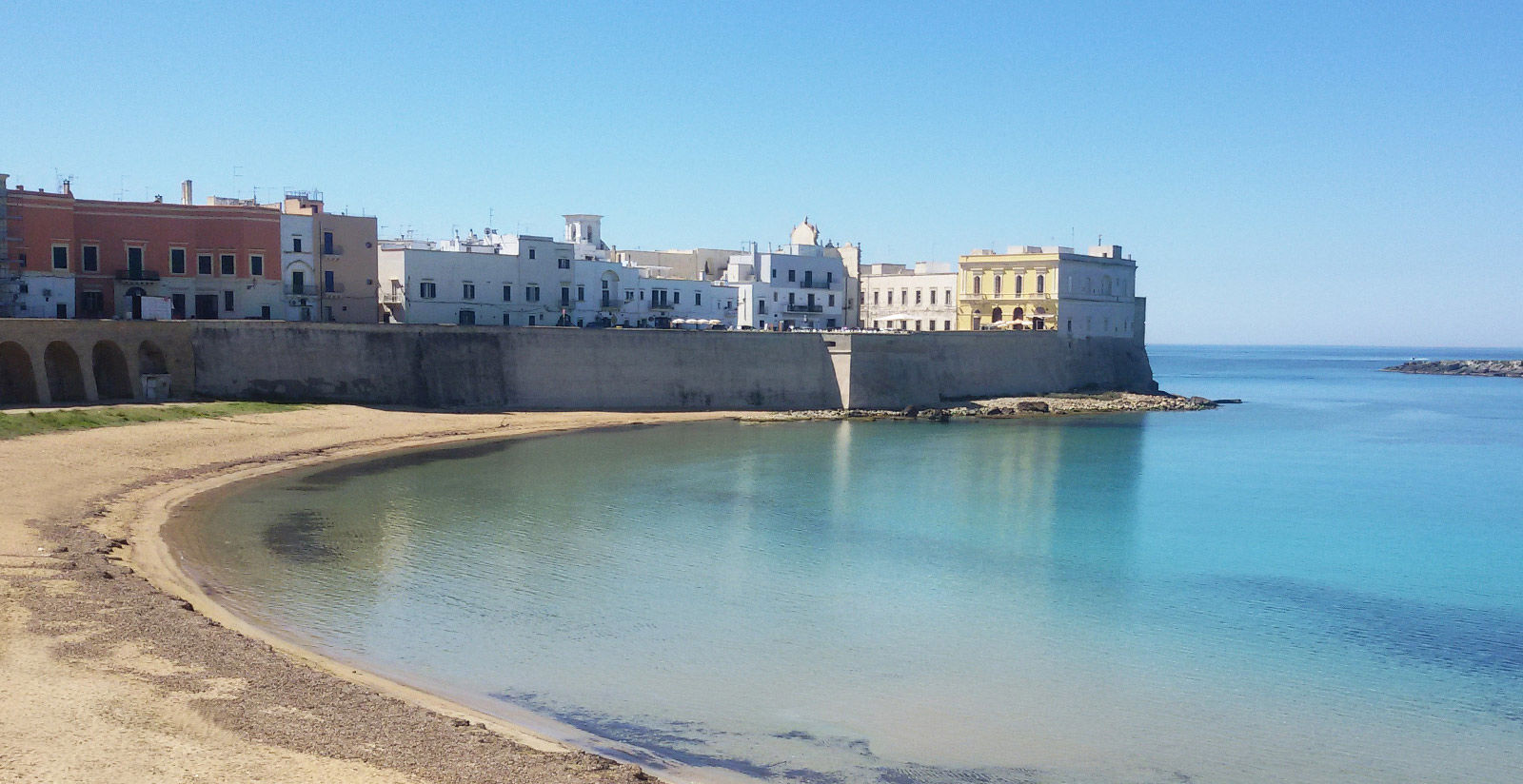It looks out onto the Ionian Sea and is split into two parts, the modern town and the historic centre. The former is the most recent part of the town, built on a peninsula that stretches out westwards into the Ionian which includes all the new buildings, such as for example the glass building (also called the Skyscraper).
While the historic centre is located on an island of limestone origin, linked to the mainland by a sixteenth-century arched bridge.
The Isola di Sant'Andrea that lies at about a mile of the coast of the historic centre is of historical and natural importance.
Monuments and places of interest
The historic centre is located on an island of limestone origin, linked to the mainland by a sixteenth-century masonry bridge. Built around the 15th century, the walls and impressive ramparts defended the city against the numerous enemy attacks, especially against Saracen pirates that started to spread terror throughout the Salento region from 1480 on. The layout of the walls was rescaled during the second half of the 1800s. The residential area sprang up along the sides of the main road, Via Antonietta De Pace.
The windy streets and alleys hide masterpieces of religious and civilian architecture, reflecting the wealth of this port town. Numerous churches look out onto the sea along the walls’ perimeter, offering proof the close bond between the town’s faith and maritime vocation.
The heart of the historic centre is home to the Cathedral of Sant'Agata, a splendid example of Leccese Baroque architecture. It is easy to stumble across majestic portals and the intricate facades of noble residences from the 16th, 17th and 18th centuries, tucked away in alleyways. The marvellous underground oil press located in Palazzo Granafei, once the place where lamp oil, exported to many European cities, was produced, is of great value for an understanding of the town’s economic and social history.
Religious architecture
- Cathedral of Sant'Agata
- Church of San Francesco di Paola
- Church of San Francesco d'Assisi
- Church of San Domenico al Rosario
- Church of Santissimo Crocifisso
- Church of Santa Maria della Purità
- Church of Santa Maria degli Angeli
- Sanctuary of di Santa Maria del Canneto
- Church of Carmine
- Church of Santissima Trinità e delle Anime del Purgatorio
- Chiesa dei Santi Apostoli Pietro e Paolo
- Convent Church of Santa Teresa
- Church of Immacolata Concezione
- Church of Santa Cristina
- Church of San Pietro dei Samari
Aragonese Castle
The Angevin Castle, surrounded almost completely by the sea, was built during the 13th century under Byzantine rule. It underwent drastic changes and renovation during the Angevin and Aragonese period when a polygonal wall was added featuring round towers. The most important works were carried out by the Sienese architect Francesco di Giorgio Martini who worked for Alfonso II of Naples.
In 1522, the eastern wall called Rivellino was added, detached from the castle perimeter and defended by the sea. The top part of the tower still features the original catapults and canons used to defend the town. Access to the Rivellino is granted via a wooden drawbridge that is still standing.
The castle has large barrel and cross vault rooms, various tunnels and walkways. The castle’s shape remained unvaried until the second half of the 1800s; the moat was filled-in between 1870 and 1879 and the facade covered with the fish market building.
Town walls
Gallipoli’s town walls were built from the 14th century on and modernised during the 1500s during the Spanish rule. The town, which has always been under threat from invaders, was enclosed by walls, towers and ramparts.
There were 12 turrets or ramparts: Torre di San Francesco di Paola, Fortino di San Giorgio, Fortino di San Benedetto, Torrione di San Guglielmo, Forte di San Francesco d'Assisi, Torre del Ceraro, Baluardo di San Domenico o del Rosario, Bastione di Santa Venerandia o di Santa Venere, Muraglia di Scirocco, Torre di San Luca, Torre di Sant'Agata o delle Saponere and Torre di San Giuseppe o della Bombarda. Some of these were destroyed and squares or buildings constructed in their place.
Coastal towers
There are four coastal towers located in the Gallipoli area: (from South to North) Torre del Pizzo, Torre San Giovanni la Pedata, Torre Sabea and Torre dell'Alto Lido. The towers, all built during the 16the century, were commissioned by Charles V to defend the Salento area from Saracen incursions.
Greek Fountain
The Greek Fountain, once believed to be the oldest in Italy in so far as thought to have been built around the 3rd century BC, actually dates back to the 16th century.
The facade, which faces southwards, is split into three parts by four caryatids supporting the richly-decorated architrave measuring approximately 5 cm in height. The bas-reliefs, sculpted using slabs of local hard stone, depict scenes showing the metamorphosis of the mythological figures of Dirce, Salmace and Biblide.
The other facade, built as a support in 1765, features the coat-of-arms of Gallipoli, a Latin epigraph and the insignia of King Charles III of Bourbon. The drinking trough for animals can be found at the bottom.
Palazzo Pirelli
Palazzo Pirelli, located opposite the Cathedral, dates back to the 16th century. It was rebuilt in Baroque style and a beautiful loggia and portal were added. The building is accessed via an ancient fifteenth-century Catalan-Durazzo style portal. The interior is richly-decorated, including the ceilings of the former entrance which was converted into a pharmacy in 1814.
The ceiling features reliefs sculpted out of local Carparo stone, topped with friezes and cornices that meet in the keystone. This shows a central tile depicting the meeting of the two mythological divinities: armed Minerva (wisdom) with her favourite animals, an owl and a cockerel, at her feet, and the goddess Fortune holding a cornucopia (a symbol of abundance) and a rudder to steer the destiny of mankind.
These symbolic elements recall the fifteenth-century augural saying: Wisdom and Fortune oversee the city’s governance.
Cuisine
Typical gastronomic products from Gallipoli:
- scapece: ish is the main ingredient of Scapece which is fried and marinated between layers of breadcrumbs soaked in vinegar and saffron placed inside containers called calette in the local dialect. Saffron lends the dish its yellow characteristic colour.
- 'Mboti: typical rolls made using lamb’s lungs and liver.
- Pittule (during Christmas)
- Puccia(on 7 December)







